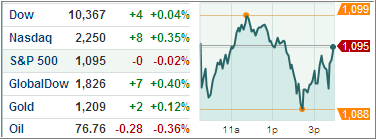 Reader Ralph had the following question regarding a topic, which I have discussed some time ago, but which is worth repeating:
Reader Ralph had the following question regarding a topic, which I have discussed some time ago, but which is worth repeating:
I am becoming familiar with your website, blog, etc. After looking closer, I am aware that your actual buying/selling is based on such things as “sell stops”, buying back into a market after certain criteria are met, etc.
However, your TTI graph identifies very specific BUY and SELL times. If I, in fact, follow only the specific BUY/SELL indicators, how much different can I expect my returns to be when compared to your actual buying/selling method (following sell stops, meeting buy in criteria, etc.)?
When a buy signal is generated via the domestic TTI (Trend Tracking Index) crossing its long-term trend line to the upside, we use that fact as a buy signal the moment a clear piercing has occurred.
On the sell side, as you mentioned, we follow the 7% trailing sell stop discipline. The use of the sell stop discipline was implemented out of the necessity to better deal with the boom/bust cycles of the economy (and its effect on the markets) that we have seen over the past decade.
If you were to wait with selling your positions until the crossing of the trend line occurs again after a bullish period, you would be giving up too much in unrealized gains and, depending on the duration of the previous rally, could turn a profitable position into a losing one.
Using a trailing sell stop as a means to step aside will lock in profits, if you have them, or limit your losses if the markets head further south. The downside is that from time to time we have to face a whip-saw signal, which means the markets stop us out, reverse course and a new rally resumes.
While that is certainly an inconvenience, it will, however, prevent us from participating in disastrous bear markets such as 2001 and 2008. That sure beats the disadvantages of a whip saw.
If you are the aggressive type, you can stay invested in the markets and use the crossing of the trend lines to the downside as your last safety net to exit and step aside. Just be aware of the shortcomings mentioned above.
As an entry point, the TTIs work well; as an exit point, my preference is to use trailing sell stops to better gain control of the ups and downs within a portfolio.





